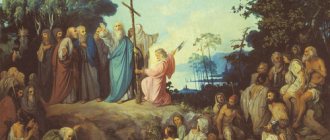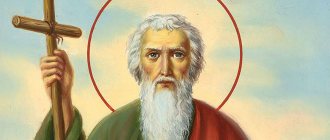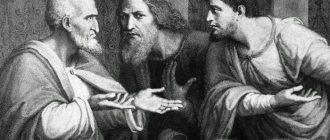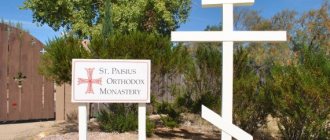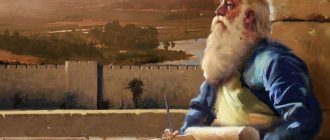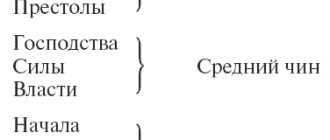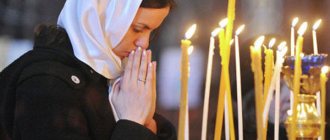Preface
Apocrypha about Andrew the First-Called.
According to the Four Gospels, Andrew was a Galilean and the brother of the Apostle Peter (Matthew, IV, 18-20). According to the Gospel of John (I, 35, 40–42), Andrew is one of the disciples of John the Baptist, even earlier than Peter, called to the Jordan by Christ (hence “First Called”). Along with these canonical news, Andrei is a character in many apocrypha; They were first mentioned by the church historian Eusebius of Caesarea (c. 263–339) with reference to Origen (185–254). The Coptic and Ethiopian “Acts of Andrew and Bartholomew” are known, which have no direct connections with Syrian, Greek, Georgian, and Latin monuments. However, a common feature for all renounced works about Andrei should be considered the fact that he is portrayed as the “apostle of the north” and the Scythians, the enlightener of the southern, eastern and northern shores of the Black Sea. Andrei chooses Sinop as his residence, from where he goes on his missions; Their northernmost limit is Tauride Chersonesos. The starting point of his last journey was also Sinop. Having enlightened Byzantium along the way, the apostle arrives in Patras of Achaia, where he ends his earthly service with martyrdom on the “St. Andrew’s” (oblique) cross. By the time Cyril and Methodius created the Slavic alphabet and writing, many apocryphal texts were circulating in Greece, the hero of which was Andrei. For South and East Slavic literature, the most important of them are “The Acts of the Apostles Andrew and Matthew and the City of the Anthropophagi” and “The Acts of the Apostles Andrew and Peter in the Country of the Barbarians.” The content of the first of them (the Slavic translation differs only in particulars from the Greek original) is as follows. Jesus divided the apostolic inheritances by lot, and it fell to Matthew to go to the country of the man-eaters. “Taking out” the stranger’s eyes, they imprisoned him and doomed him to slaughter in a few days. Matthew was healed by Christ who appeared to him, but Andrew was commanded to go to the city of man-eating people. At sea, Andrei found a ship with an unrecognized pilot, Christ, who performed various miracles along the way (an angel delivered bread from heaven to the travelers, the storm subsided, etc.). When the apostle prayed at the gates of the prison, the guards gave up the ghost; when he made the sign of the cross, the doors of the prison opened. Having freed Matthew, Andrei healed and released the prisoners who were preparing for death, then he converted the anthropophagi to God and baptized them. There are a number of publications of the Slavic “Acts of Andrew and Matthew” (St. Novakovich, M. N. Speransky, P. A. Lavrov, K. Istomin used 8 lists of the 14th–17th centuries; the latter also indicated the lists BAN 32.6.3, GPB QI801 and F.XVII.38, all XVII centuries). The oldest lists are Serbian and Bulgarian reviews, Russian ones are not older than the 16th century. “The Act of Andrew and Peter in the Country of the Barbarians” (Word of the Holy Apostles: Peter and Andrew, Matthew and Rufus, and Alexander) begins with how Andrew and his companions left the city of the man-eating people, how the apostles were raised by miraculous power to the mountain where Christ appeared to them ordered to go to preach in the city of barbarians. In a field near this city, the apostles performed a miracle: having sent a plowman for bread, they themselves began his work. Andrei plowed, and Peter sowed. Before the plowman returned, the fields were “frosted”, began to grow and ripened, which is why the plowman believed in them. But the barbarians did not want to let the apostles into the city and, in order to scare them away, they placed a naked harlot at the gate. At Andrew’s prayer, the angel lifted her by the hair “to the air,” and the path was clear. Seeing the miracle, the harlot, and after her other townspeople, converted to the true faith. The rich man Onesiphorus also wanted to join her, but the demand to leave his wealth and loved ones enraged him, and he began to beat Andrei and Peter. Hearing that it was easier for a camel to pass through the eye of a coal than for a rich man to enter the kingdom of heaven, Onesiphorus began to mock Peter and demand proof. At Peter’s prayer, in front of the barbarians, the camel passed into the coal’s eye, and Onesiphorus finally believed. This is the plot of the Greek apocrypha. Slavic lists do not reproduce it in full. In the protograph of two of them (published by K. Istomin on Zlatostroy of the 12th century and the unpublished list of the GPB, Soph. collection, No. 1261, sheets 25–25 volumes, 14th–15th centuries), apparently there was mechanical damage (no beginning, and the episode with Onesiphorus is left unsaid). List of the 17th century (published by N. S. Tikhonravov) has a title, but ends with a miracle with a harlot and a sermon in the city of barbarians. It has been suggested that the two Greek Acts originally constituted one monument. The former connection can be judged by the beginning of the second “Acts” (cf. Slavic translation: “For the apostles of Christ came out from the city of man-eating ...”). However, in the Greek manuscript tradition, monuments exist only separately; separately they could have appeared among the Slavs. However, the question of the time, place and relationship of Slavic translations remains open. Both “Acts” belong to the genre, which in the early indices of renounced books (Izbornik 1073, Taktikon of Nikon the Montenegrin) is called “apostolic rounds”, moreover, in the Slavic tradition there is an explanatory gloss: “That they came to the city and found a man, yelling oxen, and asking for bread. He goes to the city for bread. The apostles, without him, looked at the field and sowed it. And when you come from the grain, you find ripe wheat.” Consequently, only one monument was meant, “The Act in the Land of the Barbarians.” This needs interpretation, because the Slavic “bypass”, like the Greek Περιόδοι, of course, implies a group of works. Attention was drawn to the fact that the motif of apostolic help and rewards for it (the plowman brought a sheaf of a wonderful harvest to the barbarian city and told the inhabitants about everything) is found in a number of folk legends about Christ walking the earth along with the apostles and saints. The similarities between “Acts in the Land of Barbarians” and the epic about Mikul Selyaninovich were pointed out. Other apocrypha are also known in Slavic-Russian writing, in particular “From the teachings of the Holy Apostle Andrew” (M. N. Speransky published a Serbian copy of the 15th century based on materials from A. N. Popov). This, as is obvious, is a translation from “Πράξειζ 'Απ. 'Ανδρέου" (episode of section 10 of the first of Andrei's four journeys). A. belongs to the genre that Slavic indices call “apostolic teachings.” The Greek original describes a sermon in the city of Amisinov, in a synagogue. The Slavic translation does not name the place of the sermon; instead of the synagogue we find “snem”. Andrei declares that he is the first disciple of John the Baptist, then, as an eyewitness, he describes the baptism of Jesus, Andrei teaches about the ranks of angels, about the fall of the tenth order and its leader, who became the prince of darkness, about the creation of man “in his place,” speaks about Cain and his sins before the murder of Abel, about the flood and other moments of sacred history, up to the resurrection of Christ. The monument (there are many coincidences with the Historical and Explanatory Paley) was reflected in the “Tale ... of Andrei and Epiphanius about questions and answers” published by I. Ya. Porfiryev. Among the “St. Andrew’s” texts there are also pseudepigrapha, works attributed to the apostle and not of an apocryphal nature. This is the “Word of the Apostle Andrew”, published by M. N. Speransky according to the list of the 14th–15th centuries. "Yugoslavic writing"; it “doesn’t even seem Greek; perhaps it was created on Slavic soil” (CHOIDR, 1889, book 3, section I, p. 54). This short “Word” gives instructions from the standpoint of justice and Christian love. A selection of texts relating to Andrew the First-Called is placed in the VMC under November 30 (the day of his memory): “The Passion ... of the Apostle Andrew”; “The Word about the manifestation of baptism in the Russian land of the Holy Apostle Andrea, how he came to Rus'”; “The Torment... of Apostle Andrea the Holy One”; “Holy Apostle Andrea and Matthew, the work and end of Saint Andrew” (this is the Life of Andrew, written by Epiphanius of Cyprus); “The curse of Archbishop Kostyantinagrad is a word of praise to the holy Apostle Andrew”; “Holy Apostle Andrea the Exalted” (this is an excerpt from the “Tale” of Simeon Metaphrast about Andrei; according to the list of the late 17th century, the “Tale” was published by K. Istomin). A selection of military treasures is still waiting for its researcher, including the legend about the apostle’s journey through Rus'. This ancient Russian apocrypha can only formally be attributed to the genre of “detours” (or “walks”) of the apostles. In the later Greek "Πράξειζ 'Απ. 'Ανσρέου" are described, clearly by analogy with the travels of the apostle. Paul, four travels of Andrey. The third of them covers the north - Georgia, the Caucasus, Panticapaeum, Feodosia, Tauride Chersonese. Then Andrei returns by sea to Sinop, moves on to Byzantium, which he baptizes, and ends his life on an oblique cross in Patras of Achaia. Thus, the Russian legend is an insertion between the third and fourth journeys (the legend begins with Chersonesus and ends with Sinop). However, in the chronicle apocrypha the hero has no missionary goals. “By chance” (we quote the Laurentian Chronicle), that is, by accident, without any premeditated intention, he landed on the shore for the night under the Kyiv mountains, “where Kyiv would later be.” In the morning, Andrei predicted to the disciples “with him” that grace would shine on the mountains and a great city with many churches would be erected. “And when I entered these mountains, I bless and put up a cross...” The next stop is in the land of Slovenia, which is now Novgorod. The only thing that the traveler was “surprised” about here was “how to wash and tail.” Then, having overcome a long journey, Andrei gave a report in Rome only about the Novgorod baths (not a word about the Kiev cross!): “And then do this every day, not torment anyone, but torment yourself, and then do the ritual for yourself, and not torment " And then Andrei returned to Sinop. The roundabout route of the apostle should not come as a surprise: it was through Rus' that the papal legates returned to Rome from Constantinople after breaking off negotiations with the Byzantine Church (perhaps sailing in the Mediterranean Sea was dangerous). The common interpretation of the legend as a mockery of a resident of Kyiv (where steam baths were not known) at the customs of Novgorod Dev is also not suitable: if in Rome Andrei did not mention the Kiev cross, then, apparently, this is a later component of the apocrypha. It seems that the goal of this journey was precisely the “land of the Slovenes,” precisely a northern custom that was strange for a southerner. An anecdote told in the 16th century has already been compared with the chronicle apocrypha. Jesuit Dionysius Fabricius in his History of Livonia. We are talking about a case that allegedly took place in the 13th century. The brethren of the Catholic monastery in Falkenau (Livonia) demanded from the pope an increase in their allowance, citing the ascetic life, the “exhaustion of the flesh.” And indeed, the papal ambassador sent from Rome witnessed how Livonian monks, in terrible heat, whip themselves with rods, then douse themselves with ice water, and so on over and over again. The Italian saw the same thing that Andrei saw - a steam bath, but did not understand that this was “a ritual, not a torment.” According to the report of the ambassador who returned to Rome, the pope paid something extra to the monastery in Falkenau. This is a “bathhouse joke” (the northerners deceived the southerner), but the researcher of the joke, D. Gerhardt, saw here precisely “torment,” that is, some ancient rite of mortification, which only later lost its ritual functions. Of course, the bathhouse was associated with the pagan cult and could retain its relic cult functions even after Christianization. But Fabricius’ anecdote can be explained without going beyond the framework of Christianity. The 13th century is the century of the heyday of the flagellant movement (“scourges”). The flagellants themselves were scourged in monasteries, and they scourged parishioners before absolution. Processions of flagellants (the first wave - 1260) flooded Italy, Southern France, then Germany, Flanders, reaching Moravia, Hungary and Poland. Only England (and, of course, Orthodox Rus') remained aloof from this savage movement, which was ultimately condemned and banned by the papacy. But whenever the legend about the Novgorod baths got into the PVL, it happened earlier than 1260. However, flagellantism (both theory and practice) also appeared earlier. Under Charlemagne, the “self-torturer” was St. William, Duke of Aquitaine; in the 10th century St. labored zealously in this field. Romuald. The 11th century produced the flagellant theorist Peter Damiani (1007–1072), the author of the treatise “In Praise of the Scourges.” The Russian legend denies flagellantism. Over time, a “pious” version of the Novgorod legend developed, recorded in the Book of Degrees (PSRL, vol. 21, 1st half of St. Petersburg, 1908, p. 7): “...When I preached the word of God in Sinopia and Chersonia, and from then on I was on the river for him on the Dnieper, and there he prayed on the mountains and put up a cross, and blessed and prophesied in that place the existence of the city of Kiev and the entire Rus land of holy baptism. From there he came, where Veliky Novgrad now stands, and there he planted his staff in the weight called Gruzino, where now there is a church in the name of... St. Andrew the First-Called. You prefigured... with the cross on the Rusty land the sacred bureaucracy... With the Rod you transformed the royal scepter government of Rus'...". This rod is of late origin, as E. Golubinsky wrote: “The village allegedly received its name from this hoisting by the apostle (Druzino or Gruzino from the hoisting or immersion...). It is clear that the name of the village gave rise to the legend of the erection... which was supplemented by the accidental circumstance that the parish church was in the name of the Apostle Andrew" (History of the Russian Church. M., 1880, vol. 1, part 1, p. 7, note . 4). The Degree Book already contains the germ of the later cult of Andrei, who under Ivan the Terrible began to be perceived as the baptizer of Rus', and under Peter - and as the heavenly patron of Russia. Publisher: Tikhonravov. Monuments, vol. 2, p. 5–10; Novaković St. Apokrifi jednoga srpskog ćirilovskog zbornika XIV v. – Starine. U. Zagrebu, 1876. 8, s. 55–69; Porfiryev I. Ya. Apocryphal tales about Old Testament persons and events according to manuscripts of the Solovetsky Library. – SORYAS, 1877. v. 17, no. 1, p. 87–89; Lavrov P. A. Apocryphal texts. – SORYAS, 1899, vol. 17, no. 3; Istomin K. From Slavic-Russian manuscripts about the Apostle Andrew. St. Petersburg, 1904, p. 11–14. Lit.: Vasilyevsky V. Russian-Byzantine excerpts. – ZhMNP, 1877, January, p. 58–76; Sumtsov N. Essays on the history of South Russian apocryphal tales and songs. – Kiev Antiquity, 1877, September, p. 44; Malyshevsky I. I. The legend about the visit of St. to the Russian country. Apostle Andrew. – In the book: Vladimir collection. Kyiv, 1888, p. 1–51; Petrovsky S.V. Apocryphal tales about the apostolic preaching along the Black Sea coast. - Zap. Odessa islands ist. and ancient Odessa, 1897, t. 20, p. 29–148, 1898, vol. 21, p. 1–184; Pogodin A.L. The story of the walk of the Apostle Andrew in Rus'. – Byzantinoslavica. Prague, 1937–1938, 7; Gerhardt D. I) Das Land ohne Apostel und seine Apostel. – In: Festschrift für D. Čyževskyj zum 60. Geburtstag. Berlin, 1954, S. 129 ff; 2) Űber Vorkommen und Wertung der Dampfbäder. – Zeitschrift für slavische Philologie. Leipzig, 1955, Bd 24, S. 82–90; Kuzmin A.G. The Legend of the Apostle Andrew and its place in the Primary Chronicle. – In the book: Chronicles and Chronicles. Sat. articles of 1973. M., 1974, p. 37–47; Muller L. Old Russian legend about the journey of the Apostle Andrew to Kyiv and Novgorod. - In the same place, s. 48–63. N. V. Ponyrko, A. M. Panchenko
https://onlineslovari.com/slovar_knijnikov_i_knijnosti_drevney_rusi/page/… https://enc-dic.com/rusbooks/Apokrif-o-andree-pervozvannom-23/
Preface 2
In the book you will find original Greek and Latin texts and commented Russian translations of one and ancient apocrypha - “The Acts of the Apostle Andrew,” the most ancient evidence about the life of the Apostle Andrew, which was compiled between the 2nd and 10th centuries. They describe the life, preaching and death of the Apostle Andrew, and contain a lot of valuable information on the history of ancient Christianity. Most of the texts have been translated into Russian for the first time. The purpose of this book is to introduce the Russian reader to one of the most interesting and, perhaps, the most philosophical apocrypha of early Christianity. “The Acts of Andrew,” lost in its original form somewhere around the turn of the 1st and 2nd millennia, over the past century and a half have been restored, as far as possible, by several generations of researchers from various sources. And a decade and a half ago, a new history of this monument began, which suddenly attracted the close attention of the scientific world: as evidenced by the sharp increase in the 90s. 20th century number of works.
Unfortunately, in Russia, research into the Andreevsky tradition, begun in late XIX century V. G. Vasilievsky and Fr. S. Petrovsky, were interrupted by the events of 1917. And even before that time, the domestic reader knew (from the translation of the Kazan Theological Academy) only the “Letter of the Achaean presbyters and deacons,” a text far from the original. The interest in the figure of the Apostle Andrew that has increased over the past two decades in Russian society, alas, has not yet been supported by solid and scientifically reliable literature. I would like to hope that our book will change this situation somewhat. For translation into Russian, four texts were chosen that, it seems, can best characterize the first steps of St. Andrew's tradition in the Christian ecumene. These are Acta Andreae, reconstructed by J.-M. Prier according to various sources; the Latin “Book of the Miracles of the Blessed Apostle Andrew” by Gregory of Tours, which preserved the entire irretrievably lost initial part of the Greek original; “The Acts of Andrew and Matthias in the City of Cannibals” is the first and most popular continuation of the story of the apostle; and finally, the so-called. Laudatio of Nikita David Paphlagon, who at the turn of the 9th-10th centuries. subjected to rhetorical treatment both some episodes of ancient acts and the life of the First Called, compiled in the 9th century. Epiphanius the Monk.
Taking into account the traditions of the “Scrinium philocalicum” series and the recent increased desire for ancient languages among domestic readers, the translation of these monuments is accompanied in the book by the original text in Greek or Latin. The translation of all monuments was done into modern Russian without any elements of archaization, so familiar to most modern hagiographic texts. Notes on the translation are limited to indicating references to the Holy Scriptures and other texts of the St. Andrew's tradition and to conjectures in the original texts, as well as explaining the most obscure and complex passages in the monuments. It was decided to refuse to comment on ancient realities. In the notes to the text of Laudatio, attention is focused on the ancient acts of Andrew used there: the reader will find a detailed commentary on the rest of the text in the translation of Nikitin’s source - the life of Epiphanius the Monk, published in the same place from which the original Laudatio was taken. For all transcripts of the sigils to various texts, see the article “Manuscript Tradition of the Acts of Andrew.”
https://eshatos-lib.ru/files/Deyania-Andre
New in blogs
Logically, Jesus' first disciple should have known more than anyone else. If only because he was with the teacher the longest. Maybe because it was not possible to “cut this gospel” the way it was done with others?
Where is the Gospel of Andrew (the First-Called) in the Bible? - Banned?.. Why? ... Chapter 5 of the Apocrypha from Andrew begins:
“Andrei, His disciple, asked: “To which nations should we bring the good news of the Kingdom of Heaven?” Jesus answered: “Go to the nations of the east, to the nations of the west, to the nations of the south, where the children of the house of Israel live. Do not go to the pagans of the north, for they are sinless and do not know the vices and sins of the house of Israel."
This book was simply not included in the Bible. There are four Gospels there.
From Matthew, from Mark, from Luke and John. There really is no Gospel of St. Andrew the First-Called in the Bible.
The Bible does not include all the gospels, but only those that were selected by Emperor Constantine and his assistants to fulfill the tasks assigned to them.
The rest of the gospels were simply rejected, since they interpreted far from what they needed and were beneficial. And even those that were selected were considerably edited according to the situation of new times and the establishment of Christianity as the state religion.
From 364, when the New Testament was established as such, until the first edition of the Bible, the text was also edited several times. Plus translation inaccuracies played a role.
After all, the Bible was written in Hebrew, a small part in Aramaic, and the New Testament in Greek. So the first printed book, published in 1455, was already a significant difference even from the one edited in 364. Plus adjustments that were made subsequently.
As a result, we have what we have. And yet, a lot of valuable and necessary things reached people. And again, if we talk about the gospels, then in addition to those canonized by the church, there are dozens of apocryphal gospels.
In 1946, an entire library of works by Gnostic Christians was discovered in southern Egypt. There, among other literature, they discovered the so-called Gospels of Thomas, Philip, Truth, and the Apocrypha of John. And earlier, excerpts from unknown gospels, written in different versions, were found on papyri in Egypt...
Another problem here is that even the apocrypha is divided into “permissible” and so-called “renounced”.
The “abnegates”, of course, tried to destroy them. By the way, the first official list of “renounced” books was compiled in the Eastern Roman Empire in the 5th century AD.
Naturally, after such “vandalism,” descendants received only the names and quotes given in their works by Christian writers of the 2nd–4th centuries who argued with these books.
Some of these books were indeed valuable because they reflected the true Teachings of Jesus as he gave them. Therefore, they did not leave a single human soul indifferent, for the true Teachings of Jesus made people truly free from all the fears of this world.
They began to understand that the body is perishable, the soul is immortal. People ceased to be hostages and slaves of the illusion of the material world of existence. They understood that only God was above them.
They realized how short life is and how temporary the conditions into which their current body is driven are. They knew that this life, no matter how long it may seem, is just one moment in which their soul resides. They understood that any earthly power, be it politicians or religious structures, is limited to just power over bodies.
The rulers bow before their “god”, who is given power on Earth, over its matter, but not over its soul. For the soul belongs only to the true One God. And the first followers of Jesus, who professed His Teaching (and not the religion that it became later), they lost fear of this life.
They began to feel and understand that God was very close to them, closer and dearer than anyone else, and He was eternal... Such true freedom of people terribly frightened those in power.
Therefore, the latter began collecting and carefully processing the written sources already available by that time about the Teachings of Jesus. A lot was destroyed after selecting the information they needed to create a new religion, implanted by those in power, as they say, from top to bottom.
In general, the Gospel of St. Andrew the First-Called was rejected because it did not fit in with the “cutting and sewing” of the new religion. Mainly for two reasons.
Firstly, it was too freedom-loving and truthful, for the true words of Jesus were written there, as they say, first-hand. And the very style of presentation of the Teachings of Jesus was too simple, wise and intelligible.
Andrei also described details from the real life of his Teacher , that Jesus was in the East in his youth, which again did not fit into church dogma. And, besides, the mention of the lotus seed put their “Majesty of the censors” into a complete dead end.
After all, this already smacked of such religions as Buddhism and Hinduism.
No one wanted to mix such bright foreign symbolism into their own religion. So this became another stumbling block, disputes and strife between those who decided in what “colors” the ideology of a given religion should be maintained.
That’s why they removed the Gospel of St. Andrew the First-Called, as they say, away, “out of sight.”
Preface 3
[Greek ̓Ανδρέου Πράξεις, lat. Acta Andreae], early Christ. apocrypha. An attempt to reconstruct the text of the original that has not reached us was made by J. M. Prieur, who analyzed all its later revisions. The appearance of A. d. dates back to the 2nd half. II century (probably about 150); the place of their creation remains a matter of debate: it could be like Greece - the place of the martyrdom of St. Andrew, and M. Asia, Syria or Egypt. In the 3rd century. AD, along with the acts of the apostles Peter, Paul, John and Thomas, were included in the so-called. Corpus Leucius. For the first time they are mentioned among other non-canonical texts in the 1st quarter. IV century Eusebius of Caesarea (Church history III 25.6); St. Epiphanius of Cyprus, denouncing the heretical nature of this work, attributes it to the Apotactites (Apostles) or Origenists (Epiph. Haer. 47. 1. 5; 61. 1. 5; 63. 2. 1). Lat. writers con. IV - beginning V century Philastrius, bishop Breshiansky (Divers. her. // CCSL. T. 9. P. 255), bl. Augustine (Contra Fel. II 6) and Euodius of Uzala (De fide contra Man. 38) considered A. d. associated with the Manichaeans (their popularity in this environment is evidenced by papyrus passages from the so-called Manichaean psalter of the 3rd century, but the Manichaean the origin of A. d. is doubtful). One of the episodes of the deeds is mentioned in the Epistle of Pseudo-Titus (5th century), the author of which belonged to the Priscillian sect. The undoubted apocryphal nature of the A.D. is confirmed in the decree of Pope Gelasius I (Decretum Gelasianum, 494), where they are called “the work of heretics and schismatics.” The last of the Greek The authors mention them in the 2nd half. 9th century K-Polish Patriarch St. Photius, who considers them, like the entire “Corpus Leucius,” “mediocre, absurd and contradictory” (Bibl. 114). The original text of A.D. contained, according to Philastrius, descriptions of the acts of the apostle. Andrew, “committed by him on the way from Pontus to Greece.” The original is reconstructed primarily on the basis of the Book of Miracles of St. Andrew Gregory of Tours (Liber de miraculis beati Andreae apostoli, c. 591-592), as well as Copts. papyrus fragment of the 4th century. (Pap. copt. Utrecht I) and later treatments of the final part of the text - Arm. Martyrdom of St. ap. Andrew VI-VII centuries. ((?)րաղեաճ Ք· Աճկաճռճ գիրղ արակելակաճղ· Վեճետիկ՛ 1904. Էջ 146-167), Greek. Lives of St. ap. Andrew Epiphanius the Monk (1st half of the 9th century) and Greek. Patriarchal acts, preserved for several years. editions (BHG, N 94h, 95, 97, 98, 99c). In addition, revised passages from A.D. were included in other Greek. texts (BHG, N 94, 96, 100). According to reconstructions of the text by A.D. (J.-M. Prieur, DR MacDonald), his sermon was ap. Andrey starts to the south. shore of the Black Sea, moving through Pontus and Bithynia to the west. Due to the addition of the apocryphal legend, the Acts of Andrew and Matthias in the city of cannibals to the itinerary of A.D., it is unclear from the text of Gregory of Tours where the ap.’s journey begins. Andrew and where he performs the first miracle - the healing of a blind man. In Amasia, he resurrects an Egyptian slave from the noble city dweller Demetrius and frees the young man Sostratus from false accusations; in Sinope he casts out a demon that had entered the son of a certain Gratin; in Nicaea drives away 7 demons who lived among the tombs and stoned passers-by; He defeats these same demons a second time in Nicomedia, resurrecting a young man torn to pieces by them (in the guise of dogs). Then up. Andrew, taming the storm, crosses to Byzantium (bud. K-pol), defeats a crowd of armed robbers in Thrace with the help of an angel, and miraculously sails away from Perinthos to Macedonia. In Philippi, the apostle prevents a marriage between cousins (this episode is described in the Epistle of Pseudo-Titus), saves the young man Exoy, and with him goes to Thessalonica. There he heals the son of a city dweller, Carpian, and a demon-possessed youth, and then returns to Philippi to cure the son of a certain Media. After a series of miracles. Andrei is brought for questioning to Proconsul Virin; then he kills the serpent and sees Christ in a dream with the apostles Peter and John. Finally, app. Andrew goes to Achaia, where he converts first the proconsul Lesbia to Christ, and then (after performing a series of miracles and healings in Patras, Corinth and Megara) the wife of the proconsul Aegeates Maximilla and his brother Stratocles, for which the proconsul imprisons the apostle and then crucifies him on the cross. The theological views reflected in A.D. were analyzed by J. M. Prieur (Prieur. Andreasakten. S. 103-107). According to them, the element akin to God (“soul”, “spirit”, “mind”, “man”) was enclosed in a body and subordinated to evil principles - “time”, “movement”, “plurality” (τὰ πολλά), “being "(γένεσις); the person himself was not aware of this state due to the action of hostile demonic forces. He received the opportunity to get out of it only after the Revelation, which allowed him to realize (γνωρίζειν) his divine origin and the dominance of evil forces over himself. Revelation occurs through miracles and the preaching of the apostles. Ap. Andrey, “initiated into maieutics and mantics,” through his actions awakens self-awareness in people and strengthens it until they reach spiritual maturity. After receiving the Revelation, the disciples of St. Andrew expels from his life everything that is “outside” (ἐκτός), bodily and worldly, and rushes towards the spiritual and divine; in particular, they, like the Encratites, renounce carnal relations, the purpose of their life becomes imitation of the martyrdom of the teacher. The community of disciples (“brothers”) receives from the apostle. Andrew's "seal" that protects them from evil forces. Bliss is achieved already on earth with the acceptance of saving knowledge and liberation from sin through asceticism, but only after death does it reach fullness, when the soul is reunited with its source, remaining in peace (ἀνάπαυσις) and contemplation of God. God appears in A.D. as an unknown God, the revelation of whom is carried by the apostle. Andrey, and he becomes the source of the opened app. Andrey knowledge. God is close to those who believe in Him and cares for them. The concept of “salvation in Christ” is not found in A.D. The earthly life of Christ, His death on the cross and Coming are not the subject of apostolic preaching. Epithets of God: “Lord”, “God”, “Jesus” (these words are complete synonyms in the text; the expression “Son of God” is completely absent), “Lord”, “Unborn”, “Light”, “Life”, “Father” "", "Brother", "Greatness", "Supraheavenly", "Merciful", "Merciful", "Saving", "Best", "Beautiful", "Fair", "United". In the text of A.D. one can trace the influence of Gnosticism, Platonism, Neo-Pythagoreanism and Stoicism; at the same time, Prieur does not consider it possible to attribute this work to k.-l. certain philosophical or religious. environment. Using numerous examples, he shows that the oldest text of the acts was not Gnostic, as previously assumed (RA Lipsius, etc.), but rather an Encratite coloring with a possible Neoplatonic influence (M. Hornschuh). Along with A.D. both in Greek and in the east. Other apocryphal legends about the preaching of the apostle also arose from this soil. Andrei, wearing mostly fantastic shades. The most widespread in various editions are the acts of Andrew and Matthias (their connection with A.D. remains a matter of debate, see J.-M. Prieur, DR MacDonald), in terms of content they are continued by the acts of Peter and Andrew (BHG, N 1489) . Most of the other apocryphal acts of A. (with the exception of the “Acts of Andrew and Bartholomew” - BHG, N 2056) have survived only in the east. languages (Coptic, Arabic, Ethiopian): the acts of Andrew and Philemon, the acts of Paul and Andrew, the Martyrdom of Andrew among the Kurds (CANT, N 236).
https://www.pravenc.ru/text/115354.html
The primacy of honor and the canonical principle - “first among equals” (Matthew 20:25,26)
Addressing His disciples, Jesus Christ once said: “The princes of the nations rule over them, and the nobles rule over them; but let it not be so among you: but whoever wants to be great among you must be your servant” (Matthew 20:25,26). This covenant, which was fulfilled first of all by the Savior Himself by washing the feet of the disciples at the Last Supper, was always carefully preserved by the apostles and their successors. It formed the basis of the well-known canonical principle, according to which the senior bishop of any Local Church is “first among equals.”
However, despite the fraternal equality of the apostles, the primacy of honor was always respected among them, according to which the most zealous followers of the Savior were remembered first among all the disciples.

